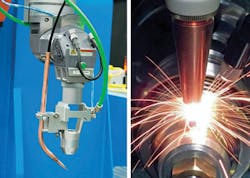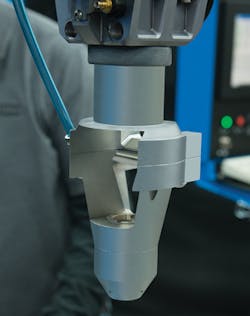Fiber laser welding enables new capabilities and flexibility
2D and 3D component welding gains ground
TERRY VANDERWERT
New capabilities and flexibility for fiber laser welding of metals and alloys is gaining the attention of many leading manufacturers, especially those in the aerospace industry. These advances center on developing process and system capabilities for welding 2D and 3D components with low-, medium-, and high-power continuous-wave (CW) and quasi-CW (QCW) fiber lasers.
Metals and alloys for which these capabilities have been demonstrated include 304 stainless steel, titanium alloys (Ti-6Al-4V and Ti-6Al-2Sn-4Zr-6Mo), and nickel-based, high-temperature alloys, including Inconel 625, Inconel 718, and Hastelloy X. The availability of high-power CW and QCW fiber lasers, with their multikilowatt-level average power, 1μm wavelength, and high brightness (beam quality), provides a laser source with new capability and flexibility (FIGURE 1).
When compared to CO2 lasers for welding, it is well documented that the 1μm wavelength of the fiber laser provides benefits in terms of simplified beam delivery using fiber-optic cables instead of turning mirrors; greater absorption by metals, especially those that are good conductors of electricity such as aluminum and copper; and less absorption by the plasma plume that is formed above the weld pool. The higher brightness of the fiber laser—compared to high-power Nd:YAG lasers—means that the laser beam, if desired, can be focused to smaller sizes, which in turn leads to increased power density. These factors contribute to deeper penetration and faster welding speed than available from previous sources of equivalent average power. They also mean more stable welding processes in a wider range of metals and alloys.
Laserdyne, with 33 years' experience installing numerous laser welding systems for aerospace (engine and airframe), automotive, electronics, fluid couplings, and medical device applications using CO2, Nd:YAG, and, more recently, fiber laser sources, has gained a unique understanding of these lasers' flexibility and capability through experience in welding high-value-added components.
Welding metals and alloys
Welding trials using a range of laser parameters and shield gases were performed at Prima Power Laserdyne. Metallography (cross-sections) and X-ray radiography were used to document the relationship between laser (spot size, laser power, etc.) and processing (shield gas type, gas flow rates, method of gas delivery, welding speed, focus position, etc.) parameters and the resulting weld geometry and structure. For example, the trials showed conditions that lead to weld porosity and those that give porosity-free welds. These trials also showed the relationship between laser and processing parameters on weld shape and profile.
The most comprehensive investigation has recently centered on laser welding aerospace alloys (FIGURE 2). The major challenge for these materials is the stringent joint requirements, with no tolerance for cracking or porosity in the weld. The weld geometry must be correct with good mechanical properties at high temperatures. Testing has proven that both CW and QCW fiber lasers are capable of welding these alloys.
However, the challenge lies in developing robust sets of laser and processing parameters that consistently produce quality welds. Laserdyne has developed the laser and processing parameters to weld the full range of aerospace alloys. Welding trials demonstrate that no single parameter controls weld quality—it is a combination of both laser and processing parameters that have a significant effect on the weld quality. These studies also show that crack and porosity-free welds can be readily produced in a range of nickel- and titanium-based alloys.
The welding trials included those with the addition of filler wire. Certain alloys and dissimilar material combinations require the addition of filler material to control the structure of the weld metal and avoid cracking to ensure the required mechanical properties. In other cases, filler metal is used to control the weld geometry to create a slight convexity (reinforcement) of the weld fusion zone. Filler material is also used to compensate for poor fit-up and mismatch during laser welding in a butt joint configuration. Laser welding with the filler wire is a multi-parameter process and there are a number of laser and filler wire parameters that determine the quality of the resultant weld. Through the aforementioned welding trials, all of the important parameters for adding filler material to produce quality welds have been optimized.
Welding trials shape new system features
One significant hardware development is a new focusing lens assembly with cross-jet design that maintains the compact profile of the Laserdyne third-generation BeamDirector called BD3Y. The cross-jet feature provides a high-velocity gas barrier that prevents metal sparks in the weld zone from contaminating the protective lens cover slide. Critical to this design is that the cross-jet also prevents contamination or interference with the welding shield gas. The cross-jet nozzle can be used with the entire range of shield gas delivery devices, including welding shoe and coaxial gas nozzle tip (FIGURE 3).
The shielding gas shoe provides a controlled atmosphere for the weld zone while it is molten and cooling to a temperature below which the material will not be compromised by the ambient atmosphere. This is important when welding materials, such as titanium alloys, that have a strong affinity for oxygen and nitrogen in the ambient atmosphere. Another important benefit of the focusing lens/shield gas assembly design for laser welding is that they are quickly changed through the cassette-mounted focusing lens to vary the focused spot size.
Enhanced control for higher quality welds
New laser control capabilities, notably laser power ramping and laser pulse shaping with sub-millisecond resolution, have been demonstrated using the Laserdyne S94P control that leads to more consistent, higher quality welds. It increases the flexibility of laser welding systems by broadening the range of materials, which are now being laser-welded. Pulse shaping has been shown effective in controlling the weld profile and structure. This is accomplished by controlling the temperature profile during weld formation and during cooling of the weld fusion and heat-affected zones.
For example, providing a lower amplitude portion of the pulse after the initial portion controls the cooling of the alloys that harden during rapid cooling of the laser beam fusion process. Another example is the use of pulse shapes with a higher amplitude on the leading edge for materials that are reflective to the laser beam, even at 1μm wavelength. Rapidly heating the surface leads to increased absorption of the laser beam and a more consistent process.
All of the features described have been standardized and are available on the company's line of 3- to 7-axis systems. The advances currently experienced with these fiber laser systems are just the beginning: new users undoubtedly will "expand the envelope" with their own unique applications, resulting in even greater productivity, quality, and economy.
ACKNOWLEDGEMENT
Laserdyne and BeamDirector are registered trademarks of Prima Power Laserdyne.
TERRY VANDERWERT([email protected]) is president at Prima Power Laserdyne, Champlin, MN.



